A History of the County of Buckingham: Volume 2. Originally published by Victoria County History, London, 1908.
This free content was digitised by double rekeying. All rights reserved.
'Parishes: Great Kimble', in A History of the County of Buckingham: Volume 2, ed. William Page (London, 1908), British History Online https://prod.british-history.ac.uk/vch/bucks/vol2/pp298-303 [accessed 23 April 2025].
'Parishes: Great Kimble', in A History of the County of Buckingham: Volume 2. Edited by William Page (London, 1908), British History Online, accessed April 23, 2025, https://prod.british-history.ac.uk/vch/bucks/vol2/pp298-303.
"Parishes: Great Kimble". A History of the County of Buckingham: Volume 2. Ed. William Page (London, 1908), British History Online. Web. 23 April 2025. https://prod.british-history.ac.uk/vch/bucks/vol2/pp298-303.
In this section
GREAT KIMBLE
Chenebella (xi cent.); Kenebell (xiii cent.); Magna Kynebell (xiii cent.); Magna Kymbell (xvi cent.).
The parish of Great Kimble lies on the northwestern slope of the Chiltern Hills and stretches down to the Vale of Aylesbury in the north. In the upland part of the parish the subsoil is chalk (fn. 1) and the surface soil chalk and flints. In the Vale the subsoil is Upper Greensand and Gault (fn. 2) and the surface soil is stiff clay. The farms in this part of the parish mainly consist of pasture lands, 1,015 acres being laid down, in all, in permanent grass. There are, however, 1,019¾ acres of arable land in the parish. (fn. 3)
The highest point in the hills is the camp in Pulpit Wood, which reaches the height of 813 ft. above the ordnance datum, while Kimblewick in the northern part of the parish is less than 300 ft. above it. (fn. 4) A brook connecting with the moat at Grange Farm runs northwards to Bonny Brook in Little Kimble parish. The latter brook also passes through Marsh, a hamlet in the north of Great Kimble parish. The road from High Wycombe to Aylesbury runs through the village of Great Kimble and at this part of its route follows the Upper Icknield Way. The Lower Icknield Way also runs through the parish. The nearest station is at Little Kimble, on the Aylesbury branch of the Great Western Railway.
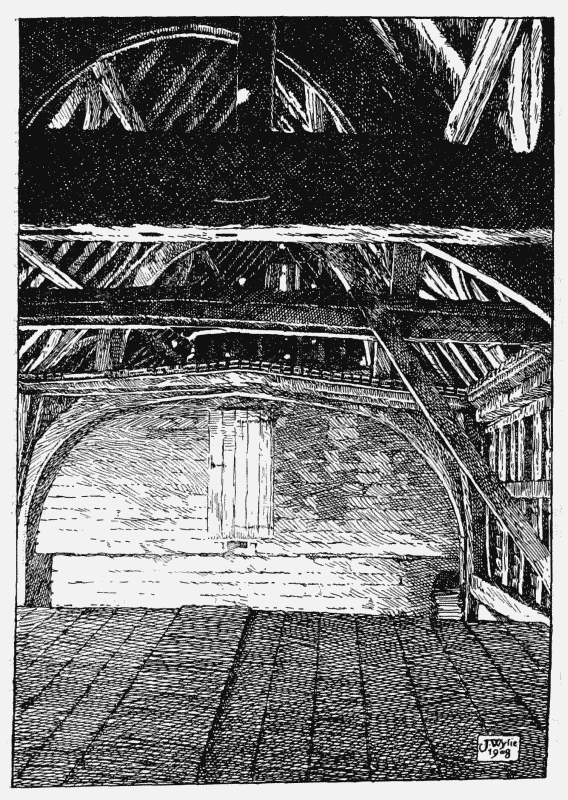
Great Kimble: Fifteenth-Century Building Now used as a Barn
There are two hamlets in the parish, Kimblewick and Marsh. On Pulpit Hill is an ancient camp and there are entrenchments and a mound to the north of the church, close to the churchyard boundary. There is a moat at Grange Farm near Great Kimble village, and at Marsh a large moat remains, but the house or buildings which it once surrounded have disappeared.
Near the church to the north-west is a large 15th-century wooden structure now used as a barn, but possibly once the church house. It is covered externally with weather boarding, but this is comparatively modern and any windows which may have been in the walls have disappeared. The roof, however, is fairly complete, and its moulded and embattled timbers are too elaborate to have belonged merely to a barn. It is of steep pitch, supported by a number of more or less restored principals with moulded tie-beams, purlins, braces, &c.
The parish of Great Kimble, together with Ellesborough and Little Kimble, was inclosed under an Act of Parliament of 43 George III; the inclosure award was dated 2 May 1805. (fn. 5)
In 1885 all the parish of Little Kimble and part of Little Hampden were united with Great Kimble parish. The area of the present civil parish of Great and Little Kimble is 3,415 acres, (fn. 6) but in 1831 the old parish of Great Kimble was returned as containing 2,570 acres. (fn. 7)
Manors
In the time of Edward the Confessor, Sired, one of the king's thegns, held GREAT KIMBLE, (fn. 8) but after the Norman Conquest it formed part of the broad lands granted to Walter Giffard. (fn. 9)
Walter also held 2 hides of land in Hartwell, which may perhaps have later become part of the parish of Great Kimble. (fn. 10) They were granted to the same sub-tenant, Hugh de Bolebec, so that such a transference seems possible, since no land in Hartwell appears to have belonged to Walter Giffard's descendants. (fn. 11) The 2 hides had not, however, been added to Great Kimble in 1254, when it was said to contain 20 hides, (fn. 12) the same assessment having been made in the Domesday Survey. (fn. 13)
Walter Giffard was made Earl of Buckingham, (fn. 14) and his lands formed the honour of Giffard, of which Crendon, in the hundred of Ashendon, was the head in England. (fn. 15) On the death of the second earl, Walter Giffard, in 1164, (fn. 16) the honour came into the hands of the Crown. (fn. 17) It was not divided amongst the descendants of Rohais, daughter of the first earl, until the reign of Richard I. (fn. 18) Her heirs were William Marshal, Earl of Pembroke, and Richard de Clare, Earl of Hertford. (fn. 19) Crendon went to the Clares, but Great Kimble formed part of the Marshals' moiety. (fn. 20) In 1254 the overlordship of the three knights' fees in Kimble was held by Simon de Montfort, Earl of Leicester, (fn. 21) in dower, together with his wife Eleanor, the widow of the second William Marshal, Earl of Pembroke. (fn. 22) On the death of the last Earl Marshal without children, Great Kimble was assigned to Eva de Braose, one of his sisters and co-heiresses. (fn. 23) Eleanor outlived Eva, but in 1275 the escheator was ordered to deliver her purparty to the heirs of Eva, who were Roger Mortimer and his wife Maud, Eudo la Zouche and his wife Milicent, John de Hastings and Humphrey de Bohun. (fn. 24) None of these heirs, however, seem to have obtained the overlordship of the fees in Kimble, and in 1284–6 it was held in chief by Gilbert de Clare, Earl of Gloucester, (fn. 25) inheriting them from Isabel, another sister of the Earl of Pembroke. (fn. 26) Thus Great Kimble was united with the other moiety of the honour of Giffard, of which Crendon was the head.
In the 14th century these fees seem to have been claimed by Aymer de Valence, Earl of Pembroke. (fn. 27) He had inherited the lands of the Munchesney family, (fn. 28) and Warine de Munchesney had married Joan, one of the five sisters of William Marshal, Earl of Pembroke. (fn. 29) Aymer had thus a claim equal to that of Eva de Braose and the Earl of Gloucester to the three fees in Kimble, but they do not seem to have been divided, since in 1403 Edmund Earl of Stafford is said definitely to hold three knights' fees. (fn. 30) In spite of this Aymer de Valence, (fn. 31) his co-heiress Elizabeth Comyn, and her husband Richard Talbot, (fn. 32) and their son Gilbert, are all said to have held knights' fees in Kimble. (fn. 33)
Walter Giffard sub-infeoffed Hugh de Bolebec of his land in Great Kimble. (fn. 34) Hugh was succeeded by his son, another Hugh, who confirmed various grants made by sub-tenants to the abbey of Missenden, (fn. 35) and in 1166 he held twenty knights' fees of the honour of Giffard. (fn. 36) He was succeeded by Walter de Bolebec. (fn. 37) The latter died before 1190–1, leaving only daughters. One of these, Isabella, was in the wardship of Aubrey de Vere, Earl of Oxford. (fn. 38) She married his eldest son Robert, and became Countess of Oxford in his right. (fn. 39) Early in the 13th century she held the mesne overlordship of three knights' fees in Great Kimble, (fn. 40) which was inherited by her son, (fn. 41) and was. held by the de Veres until the abolition of feudal tenures. (fn. 42) In 1632 Robert de Vere, Earl of Oxford, died seised as overlord of three knights' fees, his lands passing to his son and heir Aubrey. (fn. 43)
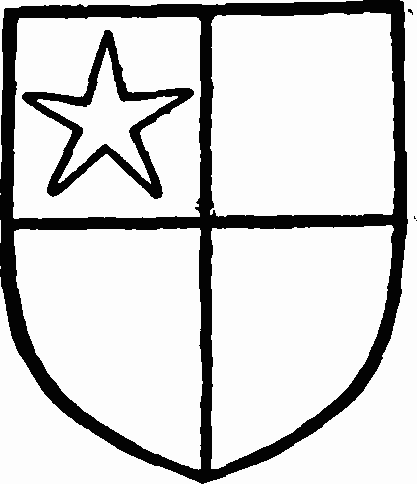
Vere, Earl of Oxford. Quarterly gules and or with a molet argent in the quarter.
The chief sub-tenant in Great Kimble under Hugh de Bolebec early in the 12th century appears to have been Giffard Palefridus of Kimble. He granted the church of Great Kimble (fn. 44) to the abbey of Missenden shortly after its foundation in 1133, (fn. 45) with a virgate of land and meadow. His son, William Giffard, or William son of Giffard de Kimble, confirmed this grant, (fn. 46) and his grandson Richard Giffard made additional grants. (fn. 47) Hugh de Kimble, presumably the son of Richard Giffard, died about 1205–6, when a regrant of the wardship of his heir was made to Adam de Essex. (fn. 48) John son of Hugh de Kimble made large grants in the parish to the abbey and to variousmembers of his family. (fn. 49) His mother Amice married Geoffrey Crok, and they obtained from John a grant in fee for the yearly rent of 2d. of one-third of one knight's fee, and one 'yoke' of land (fn. 50) in Kimble. This must have been the land that hitherto Amice had held in dower for life, and since she would be entitled to dower in one-third of her husband's whole estate, he must have held one knight's fee in demesne during his life. John de Kimble seems to have left no sons at his death, since shortly after the grant to Geoffrey Crok, the tenants of the three fees were Emma and Maud, who may have been his daughters and heiresses. (fn. 51)
From this time the land was held by tenants in demesne in three knights' fees. The Abbot of Missenden held one of these, (fn. 52) obtained mainly from alienations made by Giffard Palefridus and his successors and tenants. The other two were in the hands of Walter de Upton and Robert Fitz Neel, (fn. 53) who may possibly have obtained them by marriage with the descendants of John son of Hugh de Kimble.
In 1254 the Abbot of Missenden was said to hold 4 hides of land in Great Kimble of the gift of John de Westhull. (fn. 54) The charter of John de Westhull is given in the Missenden cartulary, but the abbey only obtained some of its lands in Great Kimble from this benefactor. (fn. 55) In 1284 the abbot held one fee in Great Kimble of the Earl of Oxford, (fn. 56) and in 1330 in an extent of the possessions of the abbey this land is called the manor of Great Kimble. (fn. 57) After the dissolution of Missenden Abbey, the manor of Great Kimble was granted in 1541 to Michael Dormer, with all the lands belonging to the abbey in Great and Little Kimble. (fn. 58) The Dormers held the manor until 1579–80, when William Dormer sold the reversion to Griffith Hampden. (fn. 59) William Hampden died seised of this manor, (fn. 60) and it passed to his descendants with Uptons Manor (q.v.).
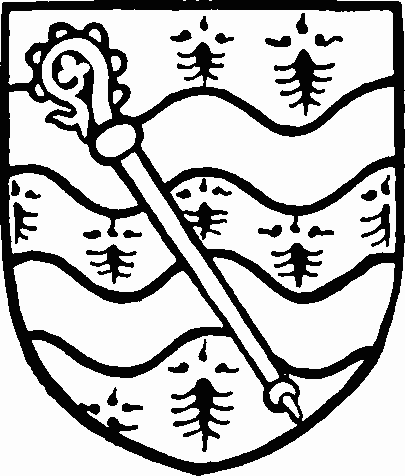
Missenden Abbey. Barry wavy ermine and sable with a crozier or bendwise.
In the 13th century FENEL'S GROVE or WHITINGHAM'S MANOR was held by the family of Fitz Neel, but it is not clear how they became possessed of it.
In a charter granting land to Missenden Abbey in the time of Henry II, Richard Fitz Neel is mentioned as a previous donor of land to the abbey, (fn. 61) and Hugh de Bolebec in a charter confirming the alienation of the church calls him 'his man.' (fn. 62) Robert Fitz Neel witnessed various charters to the abbey in the reign of Henry III, (fn. 63) and held one knight's fee in Great Kimble in 1284–6. (fn. 64) He had a son named Walter, who held land in Great Kimble. (fn. 65) Robert Fitz Neel held the fee in 1302–3 and 1316, (fn. 66) and must presumably have been his son or grandson. Robert Fitz Neel died before 1345, leaving an only daughter, Grace, the wife of Sir John Nowers. (fn. 67) She held the fee in 1346, (fn. 68) but died in 1350, and John son of John de Nowers was her heir, at that time still a minor. (fn. 69) He, however, released the manor to King Edward III, and Sir Ingelram de Couci, Earl of Bedford, who had married the king's eldest daughter Isabella or Elizabeth. (fn. 70) The earl had come to England as one of the hostages for King John of France, but had risen to great favour with Edward III. On the accession of Richard II he resigned his earldom to the king and gave up all his English land on retiring to France. (fn. 71) His wife, however, remained in England, and held the manor till her death, which took place before 1382. (fn. 72) Richard II then granted the manor to Queen Anne for her life. (fn. 73)
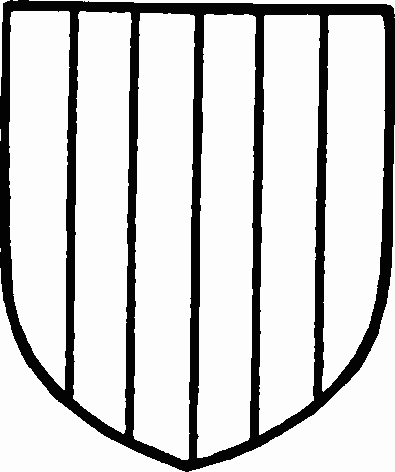
Fitz Neel. Paly argent and gules.
Henry IV apparently granted it to Queen Joan, who held it in dower in 1425. (fn. 74) He granted the reversion of the manor to his second son John Duke of Bedford, and the grant was confirmed by Henry V, the manor to remain to the duke and the heirs of his body. (fn. 75) On the death of the duke in 1435, (fn. 76) the manor passed to his nephew and heir Henry VI, (fn. 77) onethird being held in dower by Jaquetta of Luxembourg, the widow of Bedford. (fn. 78) The king in 1439 sold the manor, which at this time was known by the name of Fenel's Grove, to Cardinal Beaufort, Bishop of Winchester, to hold for the rent of 1d. a year. (fn. 79) The same year the bishop sold it to Robert Whitingham, Squire of the Household, and servant of Henry VI. (fn. 80) Various confirmations of this grant were obtained from the king. (fn. 81) Whitingham was succeeded by Sir Robert Whitingham, his son who was attainted on the accession of Edward IV, and forfeited his lands. (fn. 82) John Verney and his wife Margery, the daughter and heiress of Sir Robert, (fn. 83) attempted to recover Fenel's Grove as part of her inheritance. (fn. 84) Although their son, Sir Ralph Verney, was said to be the overlord of the manor in 1516, (fn. 85) it seems very improbable that the Verneys ever recovered possession. In 1499 Richard Whitingham was in seisin, (fn. 86) and a long lawsuit ensued between him and Richard Empson, John Danvers, Thomas Hasilwode, John Dey, and William Wodward; Empson and the other plaintiffs appear to have recovered seisin of the manor of Fenel's Grove or Whitingham's Manor in Great Kimble, after the proceedings had lasted for four years. (fn. 87) On Empson's attainder after the death of Henry VII, the 'manor of Kimble' was granted to Thomas Parre and Matilda his wife for life. (fn. 88) The estates of his father were, however, restored to Thomas Empson by Act of Parliament, (fn. 89) and he recovered the manor of Fenel's Grove amongst them. In 1538 he sold it to Michael Dormer, Alderman of London, (fn. 90) who died seised in 1545. (fn. 91) Geoffrey Dormer sold the manor in 1555 to William Serjeant. (fn. 92) Richard Serjeant was the eldest son and heir of William at the latter's death in 1562, (fn. 93) but four years later William Serjeant, sen., held Fenel's Grove. (fn. 94) He alienated parts of the manor during his life—a third to John Stampe and Isabel his wife in 1594–5, (fn. 95) and two-thirds to his son William and his wife Elizabeth. 96 (fn. 96) This William, however, seems to have held the whole manor, but alienated it in 1626 to Edward Symeon and others. (fn. 97) These were probably trustees for some settlement made by John Hampden, who married Elizabeth, the daughter and heiress of Edward Symeon. (fn. 98) Four years later William Serjeant died seised of lands and tenements in Great and Little Kimble, but not of this manor. (fn. 99) By 1653 it was held by Richard Hampden, the son of John Hampden the patriot; (fn. 100) he also held the other manors in Great Kimble, and the manor of Fenel's Grove from this time was held with Uptons Manor (q.v.).
In 1284 Walter de Upton held his fee, afterwards known as UPTONS MANOR, in Great Kimble (fn. 101) alone, but in 1302–3 he held it jointly with Hugh the Marshal, (fn. 102) and the manor apparently was divided from this time; but whether Hugh was a tenant of Walter de Upton, or whether they both held of the Earls of Oxford, does not appear.
Walter de Upton died between 1316 and 1346, (fn. 103) and John de Upton his heir died in his lifetime, leaving a daughter Joan, (fn. 104) whose husband Roger Blome held the fee in 1346. (fn. 105) His son John Blome died in 1349, but according to the inquisition made on his death, he only held lands and tenements in Great Kimble of the Earl of Oxford. (fn. 106) His daughter and heiress Matilda (fn. 107) married William Noble. (fn. 108) She died in 1377, (fn. 109) and William held her lands till his death, (fn. 110) when they passed to the descendants of Amice, sister of John de Upton, (fn. 111) who had married one of the Hampdens of Great Hampden. The Uptons' land in Great Kimble descended to her great-grandson John Hampden. (fn. 112) Richard, the eldest son of John Hampden, married Elizabeth Shingleton, the heiress of the Lutons, and thus obtained the manor of Hartwell, (fn. 113) and in consequence the land in Great Kimble passed to his younger brother Thomas, who died seised of the 'manor of Great Kimble' in 1485. (fn. 114) Richard Hampden, his son and heir, held the manor, and also died seised in 1527, leaving two daughters, Ethelreda or Audrey and Sybil. (fn. 115) The manor of Great Kimble was left to the elder daughter Audrey, who had first married William Hampden of Dunton, a member of another branch of the family, and secondly Griffin Richards. (fn. 116) The latter held the manor for life with succession to Audrey and her heirs by William Hampden, her late husband. (fn. 117) This settlement was made in 1537. (fn. 118) John Hampden, the second son of Audrey, inherited the Kimble estates, and died seised of the manor in 1558. (fn. 119) The Hampdens held the manor until 1725–6, when Richard Hampden of Great Hampden, having incurred debts to the Crown, was, under Act of Parliament, forced to sell his four manors in Great Kimble, Uptons being the principal manor. (fn. 120) The trustees sold them in 1730 by public auction to Sarah, Dowager Duchess of Marlborough, who left the manor of Great Kimble by will to her grandson John Spencer. (fn. 121) His son John Spencer, first Earl Spencer, succeeded him, but sold it in 1803 to a Mr. Richford, who conveyed it the same year to Scrope Bernard, afterwards Sir Scrope Bernard Morland, bart. (fn. 122) The latter held it at his death in 1830, but it was shortly sold to Sir George Russell, bart., (fn. 123) and at the present day it is in the hands of the trustees of his descendant, Mr. Henry FranklandRussell-Astley, a minor. (fn. 124)
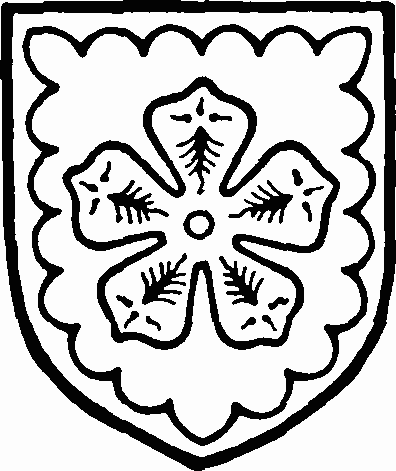
Astley. Azure a cinquefoil ermine in a bar der engrailed or.
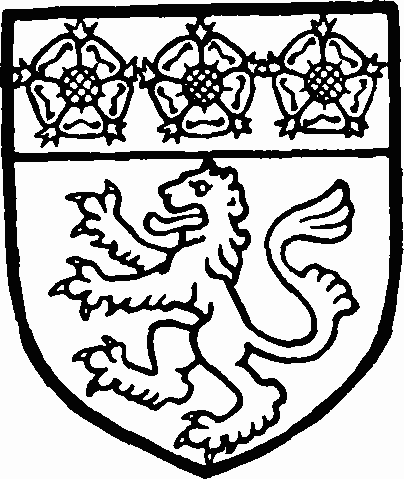
Russell. Argent a lion gules and a chief sable with three roses argent therein.
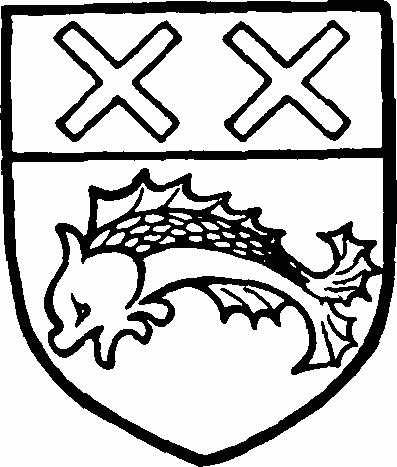
Frankland. Azure a dolphin or and a chief or with two saltires gules therein.
Ralph the Marshal held the manor of MARSHALS in Great Kimble in 1290, (fn. 125) and in 1302–3 Hugh the Marshal appears as a sub-tenant of part of the fee that Walter de Uptone had previously answered for alone. (fn. 126) In 1346 his land had passed to Thomas Marshal. (fn. 127) Sir Michael Dormer held the manor of Marshals in the 16th century, and on his death in 1545 it passed to his son Thomas. (fn. 128) Godfrey Dormer held it in 1558, (fn. 129) but probably his son William Dormer sold the reversion in 1579–80 to Griffith Hampden, who died seised of the manor. (fn. 130) On the death of William Hampden, the son of Griffith, he was found to be seised of a capital messuage (fn. 131) or farm in Kimble called Marshals, which was probably the manor of Marshals. This had been acquired by purchase from William Dormer by an indenture dated 25 January 1579–80. From this time the manor passed with the manor of Uptons (q.v.). (fn. 132)
The view of frankpledge in Great Kimble was held by the chief overlords. The bailiffs of the honour of Giffard held two views in Great Kimble, (fn. 133) this right being preserved by the Dukes of Buckingham till the 15th century. (fn. 134) On the forfeiture of their land, Henry VIII gave these courts to Edward, Prince of Wales, who held the view of frankpledge about 1548. (fn. 135)
The lords of the honour held other important regalia. Their bailiffs held the pleas of replevin and their tenants paid no hidage to the king, nor did they do suit to the shire and hundred courts. (fn. 136)
In the 13th century John son of Hugh de Kimble granted his mill in Great Kimble to Gilbert Martel, (fn. 137) who in turn granted it to the abbey of Missenden. (fn. 138) Gilbert Martel held the mill and its appurtenances for homage and service and 1 lb. of pepper paid yearly at Michaelmas, for all services, except the foreign service due to the king from two acres of land. (fn. 139) The abbot held as a sub-tenant of Martel, paying 6d. a year for the mill and all the land belonging to it. (fn. 140)
Church
The church of ST. NICHOLAS consists of a chancel 26 ft. 6 in. by 15 ft. 3 in. with north and south chancel aisles 8 ft. and 6 ft. 5 in. wide respectively; a nave 52 ft. 6 in. by 19 ft. with north and south aisles 6 ft. and 5 ft. 5 in. wide respectively; a western tower 10 ft. 10 in. square and a south porch, all measurements being internal. The early history of the church has been much obscured by recent drastic restorations, but sufficient remains to show that the aisles were added about the middle of the 13th century, at which time the nave was of the same size as at present. The old chancel has, however, completely disappeared, and the present chancel arch belongs to the early years of the 14th century.
At about the same time the tower was added, while the aisles of the chancel were built somewhat later in the 14th century. In the 15th century the clearstory was added, while in modern times the south aisle, tower, and chancel arcading have been practically rebuilt, the external surface renewed, and much new material inserted throughout.
The east window of the chancel is modern and of three trefoiled lights with cusped circular lights over and shafted jambs. On the north are two bays of arcading of 14th-century detail with obtuse twocentred arches of two hollow chamfered orders. The column is of four half-round shafts with round fillets between with circular capitals and bases, while the responds have half-octagonal corbel capitals with carved heads. Such old work as remains in the arcade is of mid-14th-century date. There is a similar arcade of two bays on the south, but of slightly different detail and not quite as much renewed. The chancel arch is of two wave-moulded orders with a modern label to the west and responds of three half-round shafts with moulded capitals and bases.
The north aisle of the chancel is lit by three modern windows of 13th-century type, a single lancet to the east and double and triple lancets on the north. At the west is a modern arch to the north aisle of the nave.
The south chancel aisle is used as a chapel and is also lit by three modern windows, that to the east being a single lancet with an elaborately moulded rear arch. The two on the south are double lancets, and that to the east has a modern piscina drain in its sill. Between these two windows is a small modern door, and there is an arch to the nave aisle similar to that on the north.
The nave is of four bays, and both arcades are of the same detail and date. The arches are twocentred and of two orders with plain and hollow chamfers, both orders being stopped at the springing. The columns are octagonal with excellently moulded capitals and bases on square plinths. Above the arcade and on a level with the sills of the clearstory windows are a series of small plain corbels, the supports of a former roof. The clearstory windows, three on either side, are on the north single trefoiled lights of 15th-century date; those on the south are modern and of two cinquefoiled lights. The tower arch is of three chamfered orders, the innermost resting on carved corbels, the outer pair dying into plain square responds.
The north aisle of the nave has on the north three windows, each of two trefoiled lights under a square head. The east and west of the three windows are of late 14th-century date much restored, but the middle one has hardly an old stone remaining. Between the pair to the west is the north door, much restored, and with plain chamfered head and jambs. The west window is a modern lancet.
The south aisle has three modern windows to the south, each of two cinquefoiled lights with square heads and quatrefoiled spandrels, while the west window is a much restored 13th-century lancet. The south door, between the westernmost pair of windows, is modern and of two chamfered orders. The south porch is also modern, with an entrance similar to the south doorway and small east and west windows of two cinquefoiled lights with a sixfoil over.
The tower is of three stages, and has been largely rebuilt. The embattled parapet is completely modern, and below it is a plain 14th-century corbel table. The belfry openings, much restored if not quite modern, are of two trefoiled lights with a blind quatrefoil over. The west door is also modern or completely restored, and is of 14th-century detail, while the west window is of 15th-century date and two cinquefoiled lights.
The font is of the common local type, of late 12thcentury date with a circular scalloped bowl and square scalloped base, the stem being moulded and the rim and base of the bowl richly ornamented with foliage.
The nave roof is of 15th-century date, low in pitch, and of the king-post type with cusped tracery in the spandrels. The other roofs are practically modern. There is a 17th-century altar table and a good chest (in the vestry) with mediaeval ironwork.
The modern fittings of the chancel are good. A curious and unusual feature is the use of Doulton ware for the reading-desk and low chancel screen.
The tower contains a ring of six bells, the treble and second cast by G. Mears in 1860, the third and fourth by Henry Knight in 1587, and inscribed respectively, 'Gloria in Excelsis Deo,' and 'Ave Maria Gracia Plena.' The fifth and tenor were cast by Mears & Stainbank in 1897.
The communion plate is modern. The first book of the registers contains all entries from 1701, baptisms and burials running to 1802, and marriages to 1754. Marriages are continued in a separate book from 1754 to 1812, and baptisms and burials in a third book from 1803 to 1812.
Advowson
The church of Great Kimble was granted by Giffard Palefridus in the 12th century to the abbot and convent of Missenden. (fn. 141) The grant was confirmed some years later by Hugh de Bolebec, the mesne lord of the fee, at the request of three of his men, Hugh of Kimble, Richard Fitz Neel, and Humphrey de Kimble. (fn. 142) In this confirmation the grant is of the church of St. Nicholas of Kimble, the invocation being the same as at the present day. The rectory was impropriated and the vicarage was ordained before or during the episcopate of Hugh of Wells (1209–34). (fn. 143) After the Dissolution, the rectory and advowson of the church were granted to Sir Richard Dormer with the manor belonging to Missenden Abbey. (fn. 144)
William Dormer sold the reversion of the rectory and advowson and the appendant tithes in 1579–80 to Griffith Hampden, (fn. 145) and the owners of the Great Hampden estates have held them till the present day, (fn. 146) the Earl of Buckinghamshire being the patron of the living.
There is a small mission church at Marsh.
Charities
The Poor's Land consists of 4 a. or. 13 p. in the parish of Ellesborough, and an allotment in Box Field containing 3 r. 14 p. awarded under the Inclosure Act, 1803. In 1905 the sum of £5 9s. 2d. was received as rent, of which £4 4s. 6d. was distributed in bread to thirteen recipients, and £1 4s. 8d. in money to seven widows.